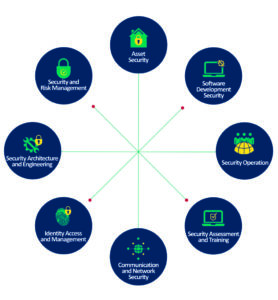The UMW CISSP training course offers a thorough review of the (ISC)2 Body of Knowledge (BoK). This BoK covers eight domains designed to help participants design, engineer, and manage an organization’s overall approach to security. Throughout the course, participants will have the opportunity to read, discuss, and complete exercises that will help them to identify areas where they need to focus more attention and areas that they have satisfied as they prepare for the exam. If you have a question about something not covered in the program overview, please feel free to send us your question, and someone will get back to you as soon as possible.
At UMW, this course will be taught in two locations – at the Stafford campus (section 001) and the Dahlgren campus (002) by an instructor who holds a CISSP designation and has the practical application of at least 3 of the domains. The course features:
-
- Official (ISC)² courseware
- Interactive flashcards
- Post-course assessment
- Collaboration with classmates
- Real-world learning activities and scenarios

Who Should Attend:
The training seminar is ideal for those working in positions such as but not limited to:
Security Consultant
Security Manager
IT Director/Manager
Security Auditor
Security Architect
Security Analyst
Security Systems Engineer
Chief Information Security Officer
Security Director
Network Architect
In this program overview you will find that after completing this course, you will be able to:
1.Understand and apply fundamental concepts and methods related to the fields of information technology and security.
2. Align overall organizational, operational goals with security functions and implementations.
3. Understand how to protect the assets of the organization as they go through their lifecycle.
4. Understand the concepts, principles, structures, and standards used to design, implement, monitor, and secure operating systems, equipment, networks, applications, and those controls used to enforce various levels of confidentiality, integrity, and availability.
5. Implement system security by applying security design principles and applying appropriate security control mitigations for vulnerabilities present in common information system types and architectures.
6. Understand the importance of cryptography and the security services it can provide in today’s digital and information age.
7. Understand the impact of physical security elements on information system security and apply secure design principles to evaluate or recommend appropriate physical security protections.
8. Understand the elements that comprise communication and network security coupled with a thorough description of how the communication and network systems function.
9. List the concepts and architecture that define the associated technology and implementation systems and protocols at Open Systems Interconnection (OSI) model layers 1-7.
10. Identify standard terms for applying physical and logical access controls to environments related to their security practice.
11. Appraise various access control models to meet business security requirements.
12. Name primary methods for designing and validating test and audit strategies that support business requirements.
13. Enhance and optimize an organization’s operational function and capacity by applying and utilizing appropriate security controls and countermeasures.
14. Recognize risks to an organization’s operational endeavors and assess specific threats, vulnerabilities, and controls.
15. Understand the System Lifecycle (SLC) and the Software Development Lifecycle (SDLC) and how to apply security to it; identify which security control(s) are appropriate for the development environment; and assess the effectiveness of software security.
Have Questions About the Program Overview Page?
Please contact Graduate Admissions at (540) 286-8030 or Email us at graduate@umw.edu, or you can fill out our Request for More Information Form. Feel free to visit our social media as well.
Facebook LinkedIn